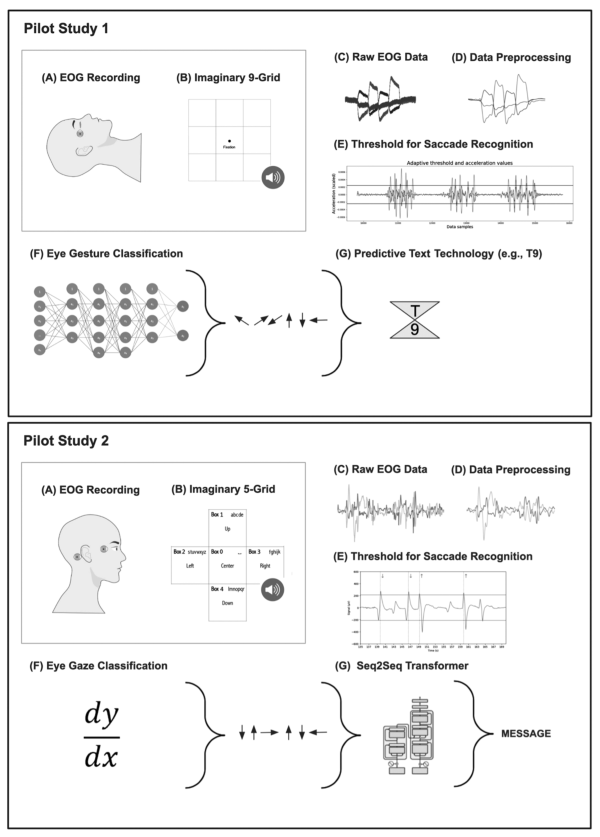Publications
Real-time dialogue between experimenters and dreamers during REM sleep
Abstract: Dreams take us to a different reality, a hallucinatory world that feels as real as any waking experience. These often-bizarre episodes are emblematic of human sleep but have yet to be adequately explained. Retrospective dream reports are subject to distortion and forgetting, presenting a fundamental challenge for neuroscientific studies of dreaming. Here we show that individuals who are asleep and in the midst of a lucid dream (aware of the fact that they are currently dreaming) can perceive questions from an experimenter and provide answers using electrophysiological signals. We implemented our procedures for two-way communication during polysomnographically verified rapid-eye-movement (REM) sleep in 36 individuals. Some had minimal prior experience with lucid dreaming, others were frequent lucid dreamers, and one was a patient with narcolepsy who had frequent lucid dreams. During REM sleep, these individuals exhibited various capabilities, including performing veridical perceptual analysis of novel information, maintaining information in working memory, computing simple answers, and expressing volitional replies. Their responses included distinctive eye movements and selective facial muscle contractions, constituting correctly answered questions on 29 occasions across 6 of the individuals tested. These repeated observations of interactive dreaming, documented by four independent laboratory groups, demonstrate that phenomenological and cognitive characteristics of dreaming can be interrogated in real time. This relatively unexplored communication channel can enable a variety of practical applications and a new strategy for the empirical exploration of dreams.
Citation: Konkoly, K. R., Appel, K., Chabani, E., Mangiaruga, A., Gott, J., Mallett, R., ... & Paller, K. A. (2021). Real-time dialogue between experimenters and dreamers during REM sleep. Current Biology, 31(7), 1417-1427.
Link: https://www.cell.com/current-biology/fulltext/S0960-9822(21)00059-2
Involvement of the Institute of Sleep and Dream Technologies: The Institute of Sleep and Dream Technologies was involved in the analysis of the data and the writing of the manuscript.
Additional info: The publication received a lot of media attention, including TV and radio interviews, and was covered by several newspapers and online news outlets (examples see screenshot).
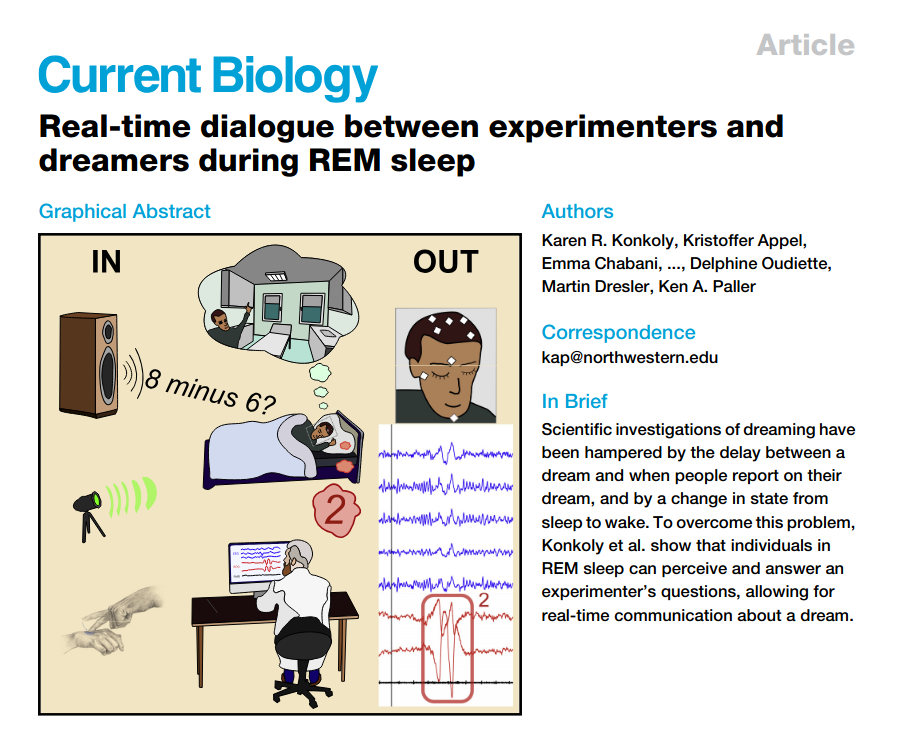
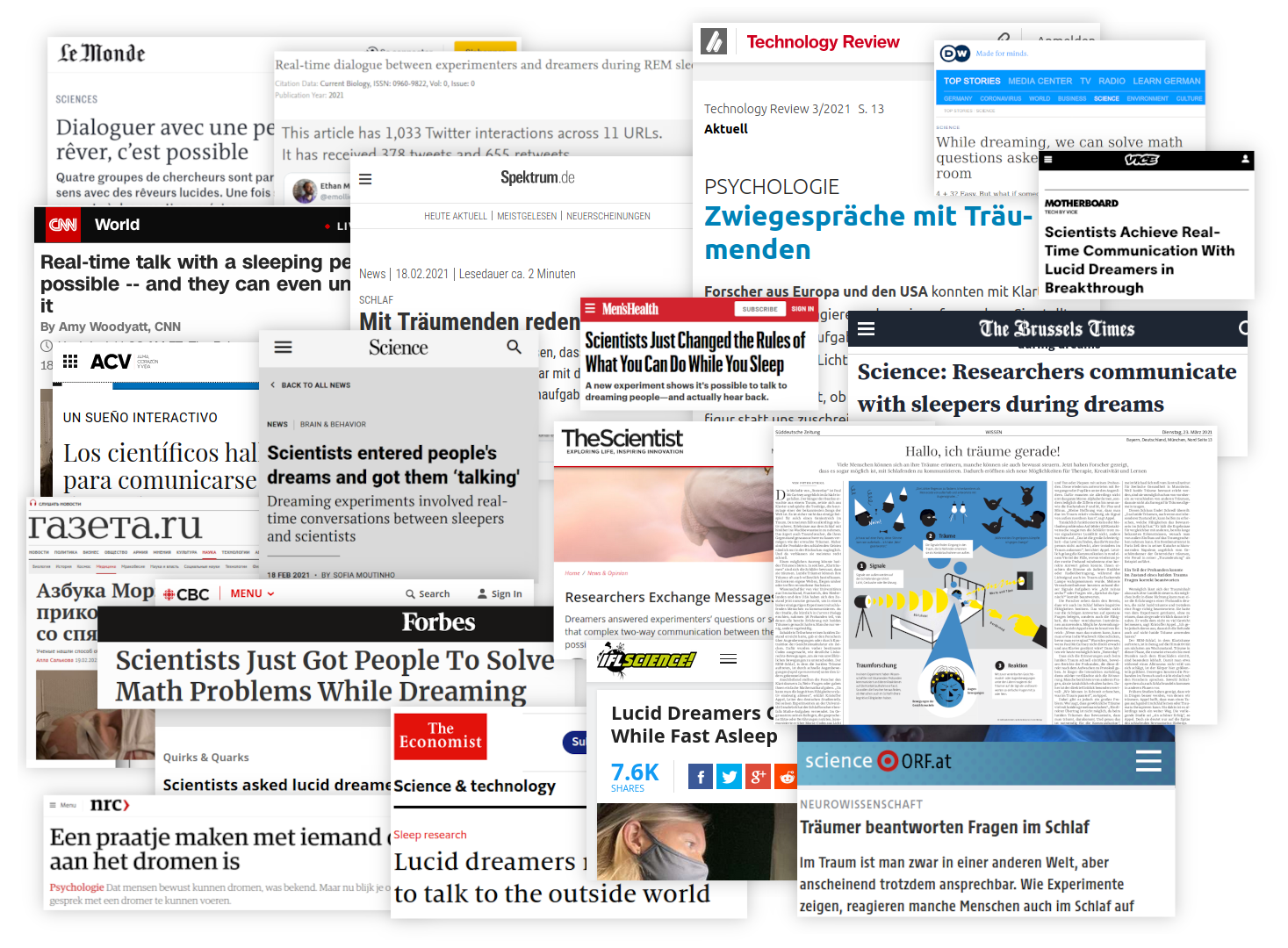
Citizen neuroscience: Wearable technology and open software to study the human brain in the natural habitat
Abstract: Citizen science allows the public to participate in various stages of scientific research, including study design, data acquisition, and data analysis. Citizen science has a long history in several fields of the natural sciences, and with recent developments in wearable technology, neuroscience has also become more accessible to citizen scientists. This development was largely driven by the influx of minimal sensing systems in the consumer market, allowing more do-it-yourself (DIY) and quantified-self (QS) investigations of the human brain. While most subfields of neuroscience require sophisticated monitoring devices and laboratories, the study of sleep characteristics can be performed at home with relevant noninvasive consumer devices. The strong influence of sleep quality on waking life and the accessibility of devices to measure sleep are two primary reasons citizen scientists have widely embraced sleep research. Their involvement has evolved from solely contributing to data collection to engaging in more collaborative or autonomous approaches, such as instigating ideas, formulating research inquiries, designing research protocols and methodology, acting upon their findings, and disseminating results. In this article, we introduce the emerging field of citizen neuroscience, illustrating examples of such projects in sleep research. We then provide overviews of the wearable technologies for tracking human neurophysiology and various open-source software used to analyse them. Finally, we discuss the opportunities and challenges in citizen neuroscience projects and suggest how to improve the study of the human brain outside the laboratory.
Citation: Jafarzadeh Esfahani, M., Sikder, N., Ter Horst, R., Daraie, A. H., Appel, K., Weber, F. D., ... & Dresler, M. (2024). Citizen neuroscience: Wearable technology and open software to study the human brain in its natural habitat. European Journal of Neuroscience, 59(5), 948-965.
Link: https://onlinelibrary.wiley.com/doi/full/10.1111/ejn.16227
Involvement of the Institute of Sleep and Dream Technologies: The Institute of Sleep and Dream Technologies was involved in the conceptualization, the writing of the original draft, review and editing.

Combining presleep cognitive training and REM-sleep stimulation in a laboratory morning nap for lucid dream induction
Abstract: Previous experiments combining cognitive techniques and sleep disruption have been relatively successful in inducing at-home lucid dreams (LD) over training periods of 1 week or more. Here, we induce LD in a single laboratory nap session by pairing cognitive training with external stimulation. Participants came to the laboratory at 7:30 a.m. or 11:00 a.m. and during polysomnography setup were provided with information about lucid dreaming. For 20 min prior to sleep the experimenter played alternating audio and visual cues at 1-min intervals. Participants were instructed to practice a mental state of critical self-awareness, observing their thoughts and experiences each time they noticed a cue. This procedure associated the cues with the trained mental state. Subsequently, participants were allowed 90 min to nap, and the audio and visual cues were presented during REM sleep to activate self-awareness in dreams and elicit lucidity. A control group followed the same procedure but was not cued during sleep. All participants were instructed to signal their lucidity by looking left and right 4 times (LR signal). Signal-verified lucid dreams (SVLDs) qualified as dreams in which the LR signal was observed and the participant reported becoming lucid. Across the 2 nap times, this protocol induced SVLDs in 50% of cued participants. In the absence of cueing during sleep, participant SVLD rate was 17%. Of note, 3 successful participants had never before experienced a LD, suggesting this protocol may be effective across the general population. Implications of this Targeted Lucidity Reactivation protocol for nightmare treatment are discussed.
Citation: Carr, M., Konkoly, K., Mallett, R., Edwards, C., Appel, K., & Blagrove, M. (2023). Combining presleep cognitive training and REM-sleep stimulation in a laboratory morning nap for lucid dream induction. Psychology of Consciousness: Theory, Research, and Practice, 10(4), 413.
Link: https://psycnet.apa.org/record/2020-24631-001
Involvement of the Institute of Sleep and Dream Technologies: The Institute of Sleep and Dream Technologies provided technological support, especially the Traumschreiber high-tech sleep mask, and contributed to the writing of the manuscript.
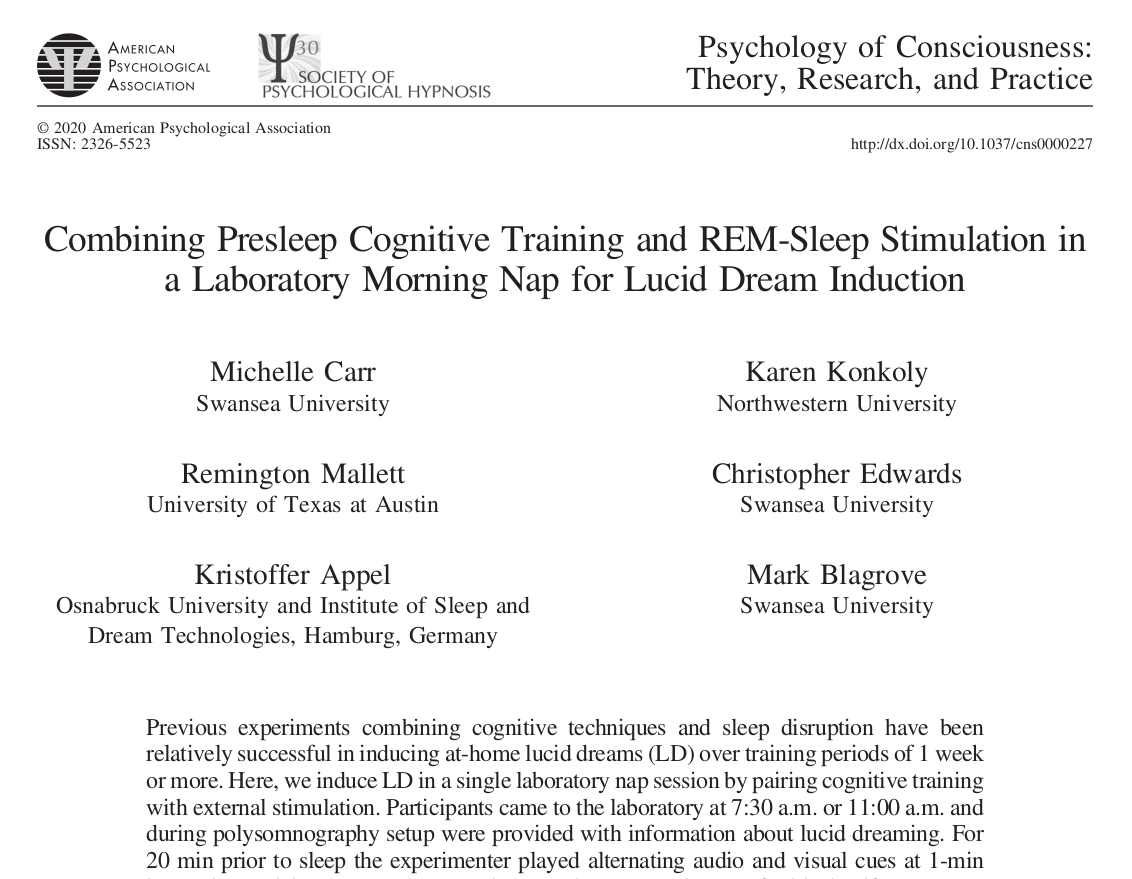
Inducing signal-verified lucid dreams in 40% of untrained novice lucid dreamers within two nights in a sleep laboratory setting
Abstract: Dreams in which the dreamer is aware of the dream state (lucid dreams, LD) are difficult to induce in naïve subjects in-laboratory. Recently, Stumbrys and Erlacher (2014) used a combination of existing induction techniques together with a self-developed experiment protocol and achieved comparatively high LD induction rates. In this study, we simplified their methodology slightly and repeated their experiment with twenty naïve subjects who spent one or two nights in our sleep laboratory. After about six hours of sleep, they were woken up during REM sleep and engaged in a series of cognitive tasks before going back to bed. Ten subjects reported a LD during the following period of sleep in one of the nights. Eight of these subjects gave a predefined eye signal, which was clearly visible in the electrooculogram during REM sleep. In summary, we replicated Stumbrys and Erlacher’s results using a simplified version of their induction protocol.
Citation: Appel, K., Füllhase, S., Kern, S., Kleinschmidt, A., Laukemper, A., Lüth, K., ... & Vogelsang, L. (2020). Inducing signal-verified lucid dreams in 40% of untrained novice lucid dreamers within two nights in a sleep laboratory setting. Consciousness and Cognition, 83, 102960.
Link: https://www.sciencedirect.com/science/article/abs/pii/S1053810019303472
Involvement of the Institute of Sleep and Dream Technologies: The Institute of Sleep and Dream Technologies was involved in the data analysis and the writing of the manuscript.
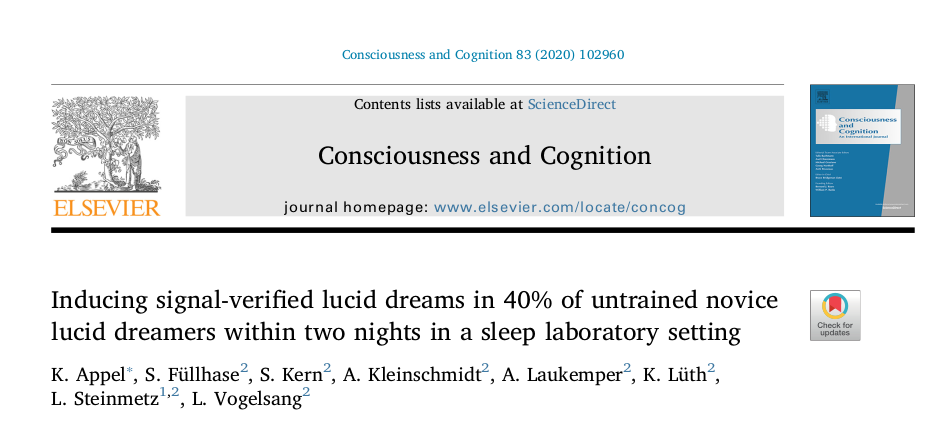
Electrophysiological correlates of lucid dreaming: sensor and source level signatures
Abstract: Lucid dreaming (LD) is a state of conscious awareness of the ongoing oneiric state, predominantly linked to REM sleep. Progress in understanding its neurobiological basis has been hindered by small sample sizes, diverse EEG setups, and artifacts like saccadic eye movements. To address these challenges in the characterization of the electrophysiological correlates of LD, we introduced an adaptive multi-stage preprocessing pipeline, applied to human data (male and female) pooled across laboratories, allowing us to explore sensor- and source-level markers of LD. We observed that, while sensor-level differences between LD and non-lucid REM sleep were minimal, mixed-frequency analysis revealed broad low-alpha to gamma power reductions during LD compared to wakefulness. Source-level analyses showed significant beta power (12-30 Hz) reductions in right central and parietal areas, including the temporo-parietal junction, during LD. Moreover, functional connectivity in the alpha band (8-12 Hz) increased during LD compared to non-lucid REM sleep. During initial LD eye signaling compared to baseline, source-level gamma1 power (30-36 Hz) increased in right temporo-occipital regions, including the right precuneus. Finally, functional connectivity analysis revealed increased inter-hemispheric and inter-regional gamma1 connectivity during LD, reflecting widespread network engagement. These results suggest that distinct source-level power and connectivity patterns characterize the dynamic neural processes underlying LD, including shifts in network communication and regional activation that may underlie the specific changes in perception, memory processing, self-awareness, and cognitive control. Taken together, these findings illuminate the electrophysiological correlates of LD, laying the groundwork for decoding the mechanisms of this intriguing state of consciousness.
Citation: Demirel, Ç., Gott, J., Appel, K., Lüth, K., Fischer, C., Raffaelli, C., ... & Dresler, M. (2025). Electrophysiological correlates of lucid dreaming: sensor and source level signatures. Journal of Neuroscience.
Link: https://www.jneurosci.org/content/early/2025/03/27/JNEUROSCI.2237-24.2025
Involvement of the Institute of Sleep and Dream Technologies: The Institute of Sleep and Dream Technologies was involved in the conceptualization of the study and review and editing of the manuscript.
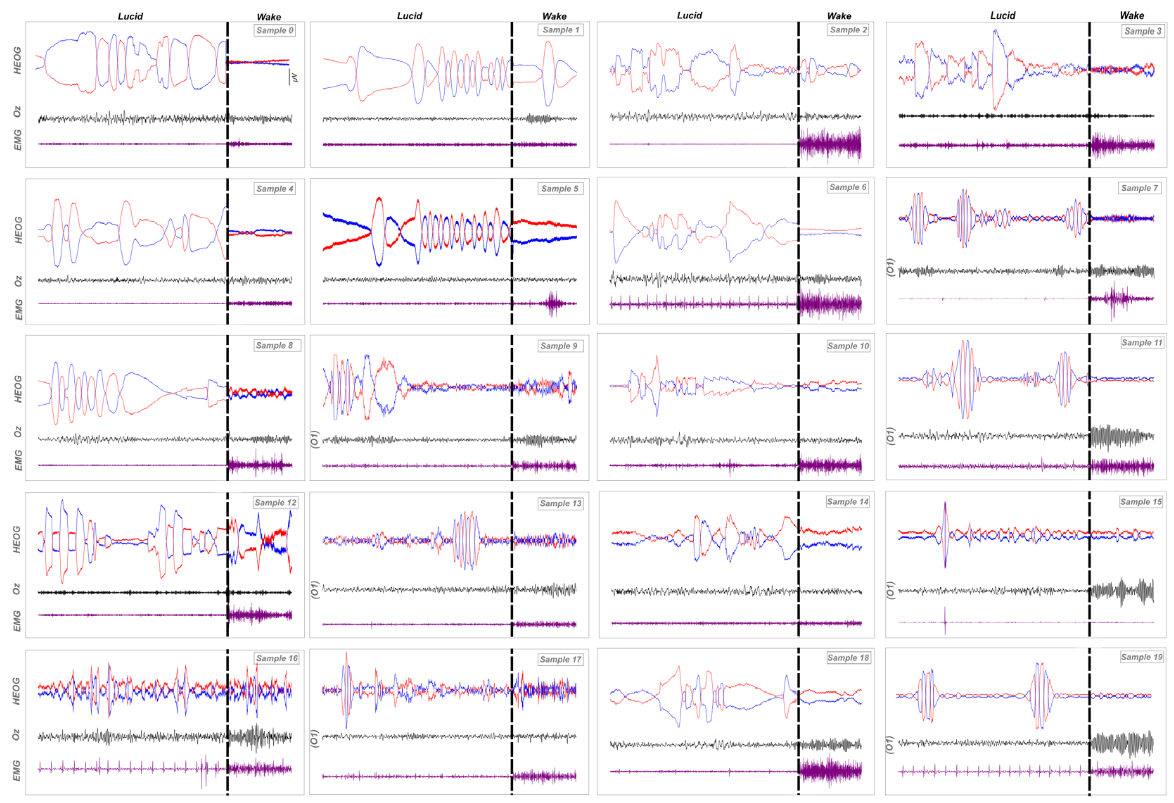
Leveraging Deep Neural Networks for Lucid Dream Communication via Two-Dimensional Electrooculography
Abstract: This article introduces a novel approach to lucid dream communication, leveraging electrooculographic signals for real-time, natural language messaging within dreams. Beyond traditional horizontal eye movement techniques, our methodology incorporates vertical eye movements, enhancing the expressive range of communication. Recognizing the potential for lucid dream communication in diverse settings, including home and laboratory environments with varying conditions, we explore two complementary approaches focusing on gesture detection and translating gestures into English words. Methodologically, we employ a grid system enabling dreamers to encode messages into eye gestures. We develop two deep neural network models for classifying and decoding eye movement data. One model integrates a dynamic threshold algorithm with a convolutional neural network for gesture classification, while the other uses a transformer-based decoding of grid-encoded eye gestures into natural language sentences. Tested in two pilot studies with awake participants, our setups exhibit promising results. In Pilot Study 1, we attained an average accuracy of 77.6% in classifying eye gestures across subjects. Pilot Study 2 demonstrates an average accuracy of 90.3% in postdecoding, successfully recovering the original English language message in most cases. This method exhibits an average eye typing speed of 19.7 characters per minute. Our results emphasize the practicality of real-time natural language dream communication, demonstrating its applicability in both laboratory and home settings. If successfully replicated during lucid dreaming states, this pioneering method holds the potential to pave the way for novel research on dreams, memory, and consciousness.
Citation: Amo, V., Godt, N., Leugering, J., & Appel, K. (2025). Leveraging deep neural networks for lucid dream communication via two-dimensional electrooculography. Dreaming. Advance online publication. https://doi.org/10.1037/drm0000304
Link: https://psycnet.apa.org/doiLanding?doi=10.1037%2Fdrm0000304
Involvement of the Institute of Sleep and Dream Technologies: The Institute of Sleep and Dream Technologies was involved in the conceptualization of the study and review and editing of the manuscript.
